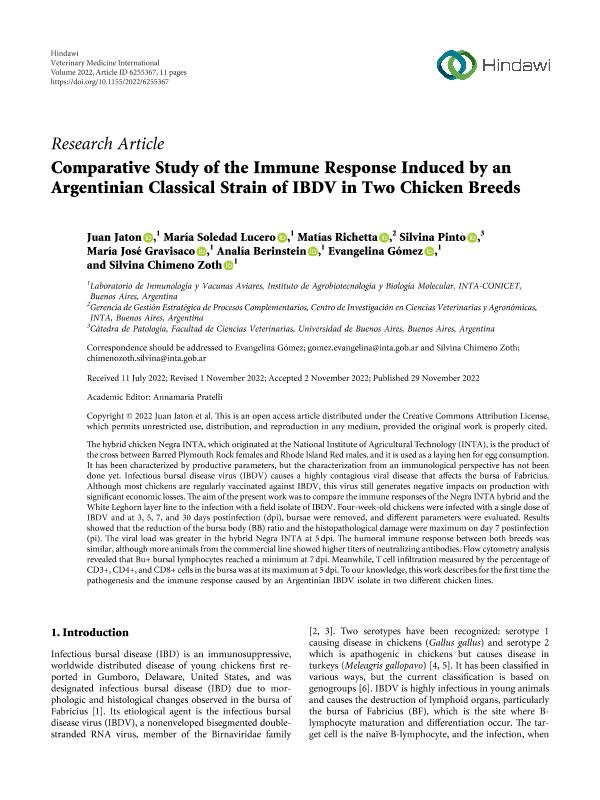Mostrar el registro sencillo del ítem
dc.contributor.author
Jaton, Juan Marcelo

dc.contributor.author
Lucero, María Soledad

dc.contributor.author
Richetta, Matías Daniel

dc.contributor.author
Pinto, Silvina
dc.contributor.author
Gravisaco, María José
dc.contributor.author
Berinstein, Analía

dc.contributor.author
Gómez, Evangelina Raquel

dc.contributor.author
Chimeno Zoth, Silvina Andrea

dc.date.available
2023-09-07T10:56:59Z
dc.date.issued
2022-11
dc.identifier.citation
Jaton, Juan Marcelo; Lucero, María Soledad; Richetta, Matías Daniel; Pinto, Silvina; Gravisaco, María José; et al.; Comparative Study of the Immune Response Induced by an Argentinian Classical Strain of IBDV in Two Chicken Breeds; Hindawi Publishing Corporation; Veterinary Medicine International; 2022; 11-2022; 1-11
dc.identifier.issn
2090-8113
dc.identifier.uri
http://hdl.handle.net/11336/210790
dc.description.abstract
The hybrid chicken Negra INTA, which originated at the National Institute of Agricultural Technology (INTA), is the product of the cross between Barred Plymouth Rock females and Rhode Island Red males, and it is used as a laying hen for egg consumption. It has been characterized by productive parameters, but the characterization from an immunological perspective has not been done yet. Infectious bursal disease virus (IBDV) causes a highly contagious viral disease that affects the bursa of Fabricius. Although most chickens are regularly vaccinated against IBDV, this virus still generates negative impacts on production with significant economic losses. The aim of the present work was to compare the immune responses of the Negra INTA hybrid and the White Leghorn layer line to the infection with a field isolate of IBDV. Four-week-old chickens were infected with a single dose of IBDV and at 3, 5, 7, and 30 days postinfection (dpi), bursae were removed, and different parameters were evaluated. Results showed that the reduction of the bursa body (BB) ratio and the histopathological damage were maximum on day 7 postinfection (pi). The viral load was greater in the hybrid Negra INTA at 5 dpi. The humoral immune response between both breeds was similar, although more animals from the commercial line showed higher titers of neutralizing antibodies. Flow cytometry analysis revealed that Bu+ bursal lymphocytes reached a minimum at 7 dpi. Meanwhile, T cell infiltration measured by the percentage of CD3+, CD4+, and CD8+ cells in the bursa was at its maximum at 5 dpi. To our knowledge, this work describes for the first time the pathogenesis and the immune response caused by an Argentinian IBDV isolate in two different chicken lines.
dc.format
application/pdf
dc.language.iso
eng
dc.publisher
Hindawi Publishing Corporation

dc.rights
info:eu-repo/semantics/openAccess
dc.rights.uri
https://creativecommons.org/licenses/by-nc-sa/2.5/ar/
dc.subject
Immune response
dc.subject
chicken
dc.subject
breeds
dc.subject
IBDV
dc.subject.classification
Ciencias Veterinarias

dc.subject.classification
Ciencias Veterinarias

dc.subject.classification
CIENCIAS AGRÍCOLAS

dc.title
Comparative Study of the Immune Response Induced by an Argentinian Classical Strain of IBDV in Two Chicken Breeds
dc.type
info:eu-repo/semantics/article
dc.type
info:ar-repo/semantics/artículo
dc.type
info:eu-repo/semantics/publishedVersion
dc.date.updated
2023-07-08T00:21:58Z
dc.identifier.eissn
2042-0048
dc.journal.volume
2022
dc.journal.pagination
1-11
dc.journal.pais
Egipto

dc.journal.ciudad
Cairo
dc.description.fil
Fil: Jaton, Juan Marcelo. Instituto Nacional de Tecnología Agropecuaria. Centro de Investigación en Ciencias Veterinarias y Agronómicas. Instituto de Agrobiotecnología y Biología Molecular. Consejo Nacional de Investigaciones Científicas y Técnicas. Oficina de Coordinación Administrativa Parque Centenario. Instituto de Agrobiotecnología y Biología Molecular; Argentina
dc.description.fil
Fil: Lucero, María Soledad. Instituto Nacional de Tecnología Agropecuaria. Centro de Investigación en Ciencias Veterinarias y Agronómicas. Instituto de Agrobiotecnología y Biología Molecular. Consejo Nacional de Investigaciones Científicas y Técnicas. Oficina de Coordinación Administrativa Parque Centenario. Instituto de Agrobiotecnología y Biología Molecular; Argentina
dc.description.fil
Fil: Richetta, Matías Daniel. Instituto Nacional de Tecnología Agropecuaria. Centro de Investigación en Ciencias Veterinarias y Agronómicas; Argentina. Consejo Nacional de Investigaciones Científicas y Técnicas; Argentina
dc.description.fil
Fil: Pinto, Silvina. Universidad de Buenos Aires; Argentina
dc.description.fil
Fil: Gravisaco, María José. Instituto Nacional de Tecnología Agropecuaria. Centro de Investigación en Ciencias Veterinarias y Agronómicas. Instituto de Agrobiotecnología y Biología Molecular. Consejo Nacional de Investigaciones Científicas y Técnicas. Oficina de Coordinación Administrativa Parque Centenario. Instituto de Agrobiotecnología y Biología Molecular; Argentina
dc.description.fil
Fil: Berinstein, Analía. Instituto Nacional de Tecnología Agropecuaria. Centro de Investigación en Ciencias Veterinarias y Agronómicas. Instituto de Agrobiotecnología y Biología Molecular. Consejo Nacional de Investigaciones Científicas y Técnicas. Oficina de Coordinación Administrativa Parque Centenario. Instituto de Agrobiotecnología y Biología Molecular; Argentina
dc.description.fil
Fil: Gómez, Evangelina Raquel. Instituto Nacional de Tecnología Agropecuaria. Centro de Investigación en Ciencias Veterinarias y Agronómicas. Instituto de Agrobiotecnología y Biología Molecular. Consejo Nacional de Investigaciones Científicas y Técnicas. Oficina de Coordinación Administrativa Parque Centenario. Instituto de Agrobiotecnología y Biología Molecular; Argentina
dc.description.fil
Fil: Chimeno Zoth, Silvina Andrea. Instituto Nacional de Tecnología Agropecuaria. Centro de Investigación en Ciencias Veterinarias y Agronómicas. Instituto de Agrobiotecnología y Biología Molecular. Consejo Nacional de Investigaciones Científicas y Técnicas. Oficina de Coordinación Administrativa Parque Centenario. Instituto de Agrobiotecnología y Biología Molecular; Argentina
dc.journal.title
Veterinary Medicine International
dc.relation.alternativeid
info:eu-repo/semantics/altIdentifier/url/https://www.hindawi.com/journals/vmi/2022/6255367/
dc.relation.alternativeid
info:eu-repo/semantics/altIdentifier/doi/http://dx.doi.org/10.1155/2022/6255367
Archivos asociados
